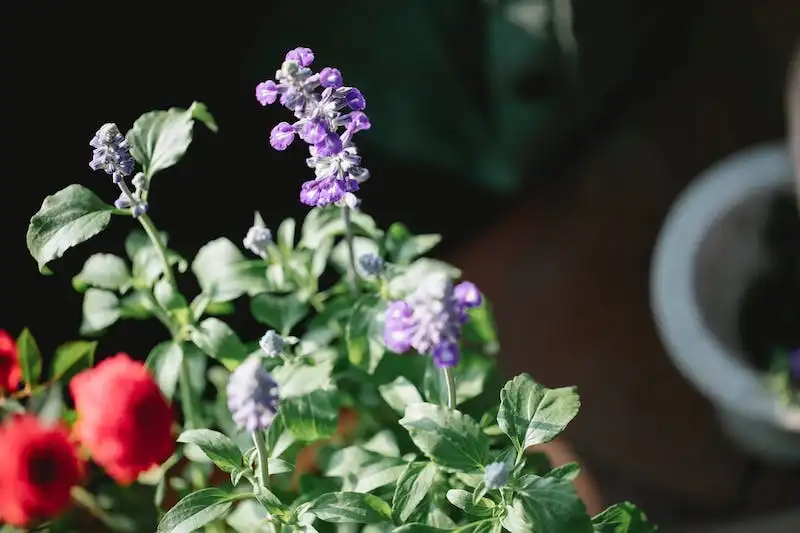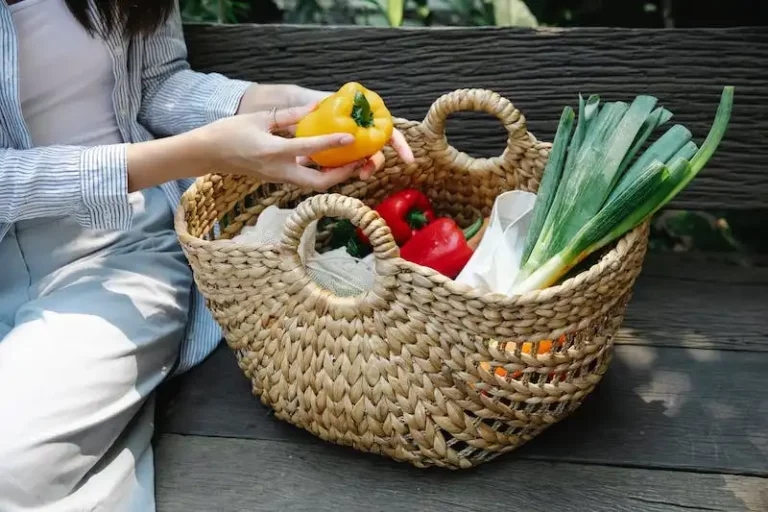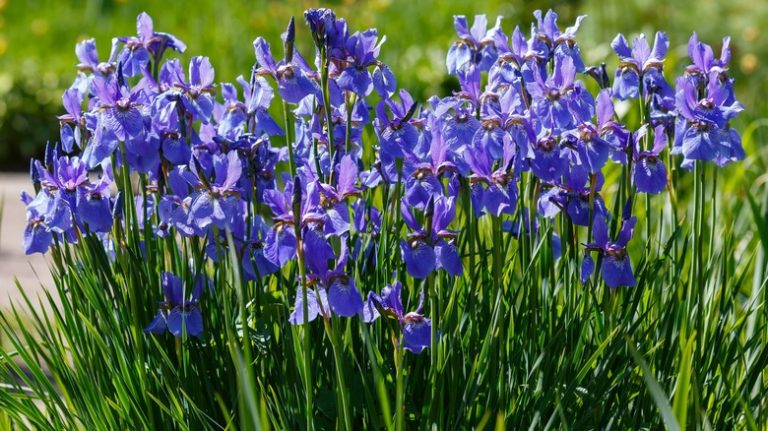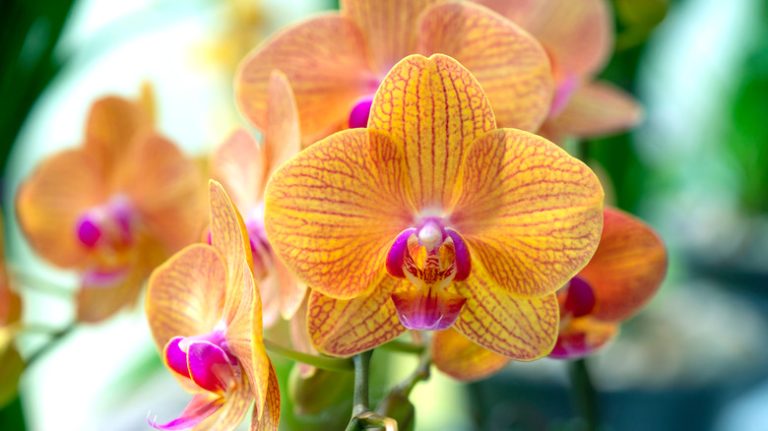Gaura, also known as the “whirling butterfly” or “bee blossom,” is a beautiful perennial plant that is often planted as a companion to roses. Its delicate and graceful appearance, with its wiry stems and butterfly-like flowers, adds a touch of elegance to any garden. Gaura is a member of the evening primrose family and is native to North America.
When planting Gaura, it is important to choose a sunny location with well-drained soil. Gaura plants prefer full sun, but they can tolerate partial shade. They also need regular watering, especially during hot summer months. Gaura has a deep root system that helps it to withstand drought conditions, but it still needs regular watering to thrive.
In terms of care, Gaura is a relatively low maintenance plant. It rarely needs pruning and is generally pest and disease resistant. However, if the plant starts to look untidy or overgrown, it can be pruned back in late winter or early spring to promote new growth and maintain its shape. Gaura can also benefit from a light application of liquid fertilizer in spring and summer to encourage healthy growth.
In colder climates, Gaura plants can be susceptible to winter damage. To protect them from frost, it is recommended to mulch around the base of the plant with a layer of organic material, such as straw or bark chips. If growing Gaura in containers, it is best to bring them indoors during the winter months to prevent frost damage.
Gaura is a favorite among pollinators, such as bees and butterflies, due to its abundant nectar-rich flowers. It attracts these beneficial insects to the garden, helping to promote a healthy ecosystem. Gaura can also be propagated easily from stem cuttings or by planting its seeds. This makes it a popular choice for both experienced and novice gardeners.
In conclusion, Gaura is a beautiful and easy-to-grow perennial plant that adds a touch of elegance and color to any garden. Its delicate flowers, massed on wiry wands above the foliage, have a unique whirling appearance that gives the plant its common name. Whether planted as a companion to roses or on its own, Gaura is a versatile and stunning addition to any garden.
How to Plant and Grow Gaura
Gaura, also known as “whirling butterflies” or “bee blossoms,” is a beautiful flowering plant that adds a touch of elegance to any garden. With its slender wands of blossoms and delicate white-lined petals, Gaura is a favorite among horticulture enthusiasts.
Gaura plants are native to North America and are often grown as perennials. The most common type of Gaura is Gaura lindheimeri, also known as “whirling butterflies.” They thrive in USDA hardiness zones four to nine and can tolerate a wide range of temperatures. In fact, they even grow well in hot and dry conditions.
When planting Gaura, it’s important to choose a location that receives full sun or light afternoon shade. Gaura needs at least six hours of sunlight daily to ensure proper growth and flowering. They also prefer well-drained soil, so make sure the planting area has good drainage.
Gaura plants are relatively low maintenance and don’t require much watering once established. However, young plants need to be watered regularly until they are well-rooted. During dry spells, it is a good idea to water them every few days to keep the soil moist. Overwatering can lead to root rot, so be careful not to water excessively.
In addition to their beautiful blooms, Gaura plants also attract pollinators such as bees and butterflies. They are a member of the same family as the coneflower and salvia, making them a perfect addition to pollinator gardens. Their tall stature and long flowering period provide a food source for pollinators throughout the season.
Gaura plants can grow up to five feet in height, but there are also dwarf varieties available that stay more compact. These shorter varieties are perfect for smaller gardens or when space is limited. Gaura plants can be planted as single specimens or in mass plantings for a stunning display.
To ensure optimal growth and flowering, Gaura plants should be pruned in late winter or early spring. Pruning helps to remove any dead or damaged foliage and promotes new growth. It is also a good idea to cut back the stems of taller varieties to prevent them from flopping over.
In conclusion, Gaura is an unusual and beautiful plant that is relatively easy to grow. Its long blooming period and attractive foliage make it a favorite among gardeners. Whether planted in a garden bed or a container on the balcony, Gaura will add a touch of elegance to any space.
Gaura Overview
Gaura, also known as beeblossoms, is a popular addition to any garden. This flowering plant is native to North America and is cultivated for its beautiful blooms and delicate foliage. Gaura plants have wiry stems that can grow up to four feet tall. They produce small, four-petaled flowers that come in a variety of colors, such as white, pink, and crimson.
Gaura is a long-lived plant that can survive in a range of growing conditions. It prefers full sunlight but can also tolerate partial shade. Gaura is known for its ability to attract butterflies and other pollinators, making it a great companion plant for a butterfly garden. Its delicate foliage adds a touch of elegance to any landscape.
When planting gaura, it is important to choose a well-drained location. Gaura plants prefer sandy or loamy soil that is not too rich in organic matter. If the soil is heavy or clay-like, add some sand or gravel to improve drainage. Gauras also do well in pots or containers, as long as they have good drainage holes.
In terms of care, gaura plants do not require much pruning. However, if the stems start to flop over, you can carefully trim them back to maintain a more compact shape. Some gardeners choose to deadhead the spent flowers to encourage more blooms. In colder climates, it is important to protect gaura plants during winter. Mulch the base of the plant with straw or leaves to insulate the roots from freezing temperatures.
Gaura is a relatively low-maintenance plant, but it will benefit from regular fertilizing. Use a balanced fertilizer, such as a 10-10-10 formula, once a month during the growing season. Water the plant frequently, especially during dry periods. Gaura does not tolerate drought well and requires consistent moisture to thrive.
Gaura is a deer-resistant plant, making it a good choice for gardens where deer are a problem. It is also resistant to most pests and diseases. However, keep an eye out for aphids or powdery mildew, which can occasionally affect gaura plants. These issues can usually be resolved by washing the plant with a mild soap solution or using an organic insecticide.
Overall, gaura is a versatile and beautiful plant that can add a touch of elegance to any garden. Its long-lived blooms and delicate foliage make it a popular choice for many gardeners. Whether grown in the ground or in pots, gaura plants are sure to bring beauty and life to your outdoor space.
Source: Plantura
Where to Plant Gaura
Gaura, also known as the wandflower or bee blossom, is a beautiful flowering plant with globe-shaped clusters of pink, purple, or white flowers. It is easily recognizable by its long, slender stems with delicate-looking flowers and long stamens.
Gaura plants prefer well-drained soil and full sunlight. They can tolerate some shade but will not flower as profusely. Therefore, it is best to plant them in a location that receives at least six hours of sunlight per day.
When choosing a spot to plant gaura, consider its mature size. The plant grows to be about two to four feet tall and about two feet wide. It is a great companion plant, and looks especially beautiful when planted in masses or close to other flowering plants such as phlox, petunias, coneflowers, and primroses. These companion plantings not only add visual interest but also attract pollinators to your garden.
Gaura plants are hardy in USDA zones five to nine and can tolerate cold temperatures. However, they are not frost-free and may require some winter care in colder climates. If you live in an area with harsh winters, it is best to provide some protection for your gaura plants, such as covering them with a layer of mulch or moving potted plants indoors.
Gaura is a low-maintenance plant and does not require much fuss. It does not need frequent watering and prefers to dry out between waterings. It is also resistant to pests and diseases, making it a great addition to any garden.
If you are unsure about how to care for your gaura plant, it is always a good idea to ask for information from a local garden center or consult a gardening website such as Plantura. They can provide you with specific care instructions based on the type of gaura you have.
Gaura is known for its ability to self-seed, so if you want to control its growth, it is best to deadhead the flowers before they go to seed. This will prevent the plant from spreading too much and taking over your garden.
In conclusion, gaura is a beautiful and versatile plant that adds an airy and whimsical touch to any garden. Its long-lasting flowers and attractive foliage make it a popular choice for many gardeners. Whether planted in the ground or in containers, gaura is a low-maintenance plant that will reward you with its charming blooms year after year.
How and When to Plant Gaura
Gaura plants, also known as beeblossoms or wand flower, are a popular choice for gardeners due to their beautiful flowers and hardy nature. In this article, we will provide you with information on how and when to plant gaura in your garden.
Gaura plants can be planted either in spring or fall, but they are generally more successful when planted in spring. Before planting, make sure that the soil is well-drained and that the planting area receives full sun. Gaura plants prefer sandy or loamy soil, so if your soil is heavy, you may need to add compost or other organic matter to improve drainage.
To plant gaura, dig a hole that is slightly larger than the root ball of the plant. Place the plant in the hole and backfill with soil, gently pressing it down around the roots. Water the plant thoroughly after planting to help settle the soil and ensure good root establishment.
Once planted, gaura plants require little maintenance. They are generally drought-tolerant and do not require much water, especially once established. However, during periods of prolonged dryness, it is a good idea to provide them with a deep watering to keep them healthy.
If you are planting gaura as a companion plant in your vegetable or flower garden, make sure to give them enough space to grow. Gaura plants can reach a height of up to five feet, so place them towards the back of the garden bed to prevent them from shading out smaller plants.
Gaura plants are generally pest and disease-free, but like any plant, they can still be susceptible to certain pests or diseases. Deer may be attracted to young gaura plants, so if deer are a problem in your area, consider using deer repellents or planting gaura in a protected area.
In addition to their beautiful flowers, gaura plants are also known for their self-seeding properties. If you want to prevent them from spreading too much, deadhead the flowers after they have blossomed. This will help to keep the plant from producing seeds and spreading throughout your garden.
Gaura plants can also be grown indoors as a houseplant. They prefer bright, indirect light and should be placed in a frost-free area during the winter months. Water the plant sparingly during this period, allowing the soil to dry out slightly between waterings.
In summary, gaura plants are a hardy and beautiful addition to any garden. Whether you plant them in the ground or in a container, they will surely be a stunning focal point with their masses of pink or white flowers. So go ahead and give gaura a try – you won’t be disappointed!




